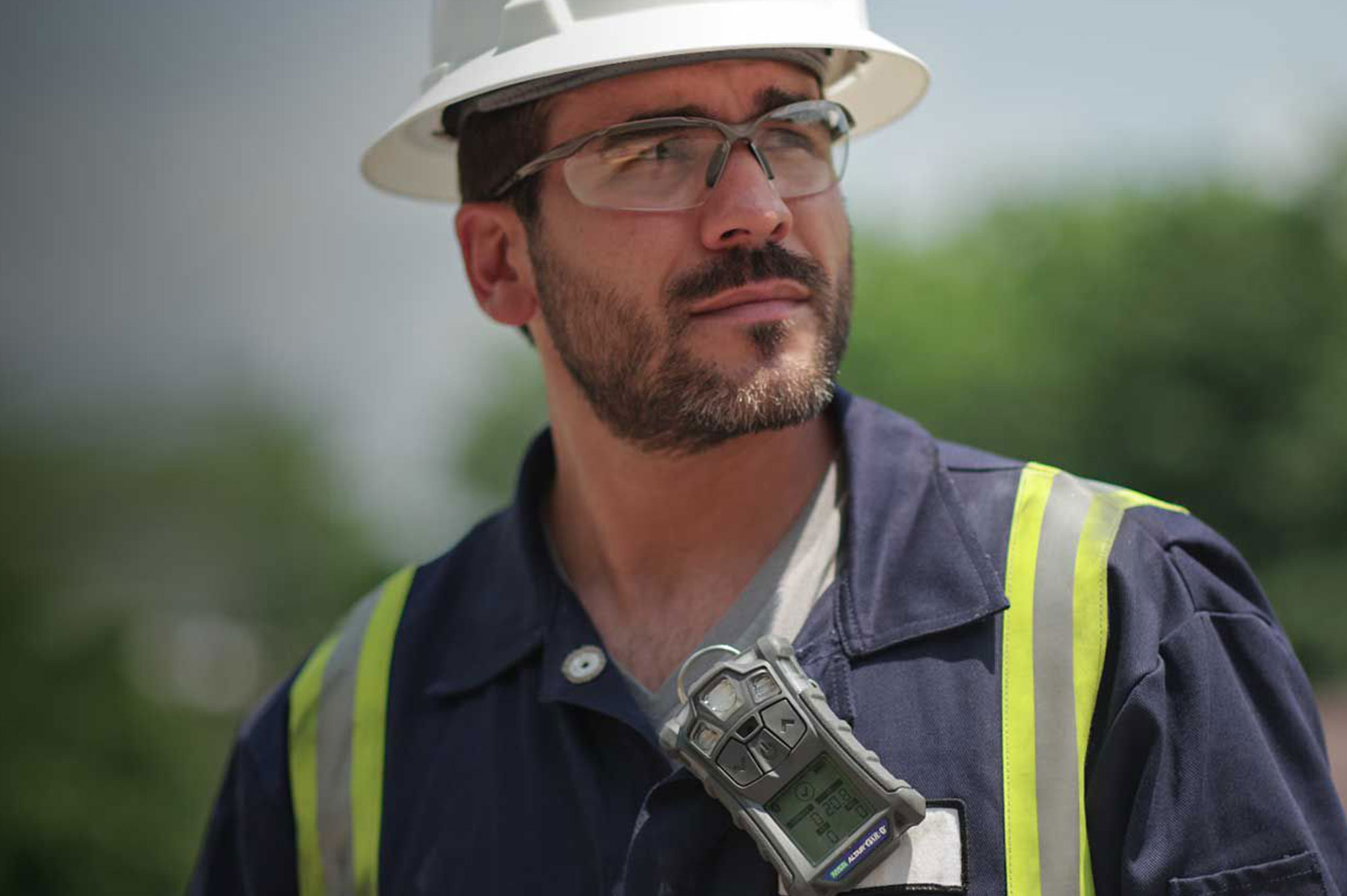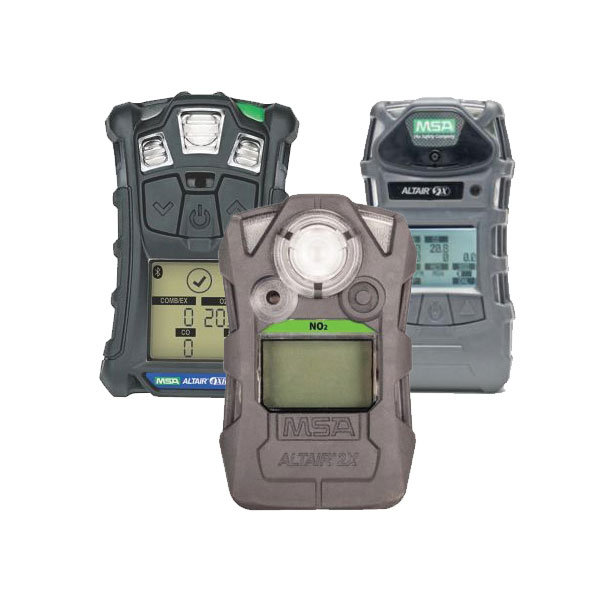Gas Detection
When it comes to gas detection, there are many fundamentals you need to understand before you can decide the type(s) of equipment you'll need to keep your employees safe starting with what conditions require gas detection. For example, prior to permit-required confined space entry air monitoring must be conducted to measure oxygen, combustible gases and toxic gases and vapors according to OSHA.

Did you know the safe O2 level is narrow?
The minimum safe level of O2 = 19.5% and the maximum safe level is 23.5%. Dipping below the minimum level can result in impaired judgement, poor coordination, nausea, loss of consciousness whereas an oxygen rich atmosphere could allow for ignition of combustible materials.
In general, gas detectors aka the '4 Gas' Meters are direct reading instruments that monitor:
- Oxygen concentration
- Lower Explosive Limits (LEL)
- Hydrogen Sulfide
- Carbon Monoxide
Did you know the safe O2 level is narrow?
The minimum safe level of O2 = 19.5% and the maximum safe level is 23.5%. Dipping below the minimum level can result in impaired judgement, poor coordination, nausea, loss of consciousness whereas an oxygen rich atmosphere could allow for ignition of combustible materials.
Understanding LEL, UEL and PEL are important when working in confined spaces.
Lower Explosive Limit (LEL) is the LOWEST concentration of a gas in air that can combust or produce flame when paired with ignition source.
- In addition to multi gas meters, there are many different single gas meters if you are only concerned with Volatile Organic Compounds, you can get different sensors to measure your LEL.
- Selective vs. Sensitive:
Multi-gas detectors are sensitive at measuring LEL, but these are not selective. They will not let you know what specific chemical they are measuring.
Upper Explosive Limit (UEL) is the HIGHEST concentration of a gas in air that can combust or produce flame when paired with ignition source.
Permissible Exposure Level (PEL) is set by OSHA and is the safe amount of exposure for an average worker for an 8-hour period. These limits vary by chemical compound and by jurisdiction.
In order to avoid combustion or an unwanted chemical reaction, proper ratios of Oxygen, Heat and Fuel must be maintained. The Fire Triangle illustrates the flammable Range is the area between the LEL and the UEL - it is the perfect concentration for fire and explosions to occur.
Understanding vapor density and its impact on stratification
Vapor density is the weight of chemical in the air. In an enclosed system, chemical vapors will stratify according to their vapor density. Thus, different gases will be measurable at different levels.
Gas/Vapor | Vapor Density |
Air | 1.0 |
Methane | 0.55 |
Carbon Monoxide | 0.97 |
Hydrogen Sulfide | 1.19 |
Gasoline Vapor | 3.0 (approx.) |
It is important to note that measurement technique and operator knowledge will impact the accuracy of gas readings. One must understand what chemicals are, or could be, present in order to properly monitor and detect gases, and be sure to allow sufficient time for the pump to correctly read the gases detected. Conducting frequent device calibration and bump tests will ensure that the meter is functioning correctly. However, atmospheric conditions including high heat and high humidity can shorten your sensor's life.
Where are gas detectors used?
- Industrial Plants
- Refineries
- Waste-water Treatment Facilities
- Confined Space Entry
In addition to speaking with an Arbill safety expert, how do you determine what gas detection solution is right for you? The following criteria should be considered when evaluating a direct reading gas detector:
- Simplicity of operation
- Reliability
- Portability
- Environmental conditions
- Storage and transport requirements
- Selective vs. Sensitive
- Intrinsically safe
- Volatile Organic Compounds / Photo Ionization Detection vs. Sensors

What gas detector is right for you?
MSA offers a variety of gas detection solutions from Single-Gas Detectors to Multi-Gas Detectors and can be customized depending on your needs.
Single-Gas Detectors run for 24-36 months and offer a maintenance-free cost-effective solution. Monitoring options include carbon monoxide, hydrogen sulfide and oxygen. These units are coupled with LED/audible/vibrating alarms and offer:
- Superior dust and water protection
- High RFI resistance
- Durability
- Ease-of-use one-button operation
MSA offers multi-gas detectors including the 4XR and 5X are capable of measuring multiple gases simultaneously.
- The 4XR is a rugged, reliable, real-time option with rapid-response sensors. It offers quick calibration and Bump LED and on-screen confirmation. The Altair 4XR calibrates with ½ the gas and ½ the time compared to the industry average. It also features a “man-down” alarm and a user-activated alarm to alert others of a potentially dangerous situation.
- The 5X is a durable Bluetooth-enabled product with an internal pump and can measure up to 6 gases simultaneously and can be customized with an optional PID (photoionization) sensor for VOC detection. It also features a “man-down” alarm and a manual alarm for confined space applications.
Is Real-Time Data Important? 3 Reasons Why the Answer Is 'Yes.'
(This blog article was originally published on the MSA Safety Blog – Spotlight on Safety. It is republished with permission.)
There's been a lot of talk in the world of safety about the need for real-time data. Although most will agree that real-time data benefits safety programs by providing information that leads to better decision making, some may wonder if real-time data is as crucial as they've heard.
The short answer is yes, and here's why.
A properly calibrated and bump-tested gas detector is a powerful personal protective device. By itself, however, it's simply not enough to help ensure the highest level of safety.
That's where a connected work platform comes into play.
A connected work platform combines real-time data, connected PPE/detection wearables, and advanced software solutions so you can have the best possible visibility across these areas of concern:
- Workers
- Worksites
- Workflows
In fact, connectivity enables the kind of visibility that can lead to a stronger safety program and improved safety outcomes.
Even better? A strategic connected worker-worksite-workflow platform helps simplify safety, curb risk, and boost productivity all at the same time. Plus, it sets you up for a scalable and adaptable safety program for today – and tomorrow.
Consider these three reasons why real-time data via a connected platform is a must for worker and worksite safety:
1. Real-time data enables real-time visibility for safety teams.
By their very nature, remote workforces leave safety managers disconnected from what's happening on the job. So, what's a disconnected and physically distant safety manager to do in the event of an unsafe incident, especially when every second counts?
Here's what they can do. They can ensure that lone workers are not alone, thanks to the visibility provided by a connected platform. If workers, worksites, and workflows are not connected, there's likely going to be too much lag time between incident and information – lag time that's costly to both worker safety and infrastructure.
With connectivity-enabled real-time data, safety managers can have continuous situational awareness. That means seeing the state of workers and monitoring their safety behaviors in the field. It means you'll get gas exposure alerts, man-down alarms, panic button presses, and device concern warnings in real-time so you can act as swiftly as possible. Plus, it means simplifying compliance and improving productivity to reduce risk and costly downtime.
Real-time data gives safety managers real-time visibility and awareness into what's happening, so they can respond to incidents – and help improve safety of workers, worksites, and workflows – much faster.
The key to leveraging critical real-time data is having your hardware or gas detection devices connected to both the right software and to the cloud through a seamlessly integrated solution. While the device does its job of collecting data, the software does its job of empowering safety managers with information and insights that let you drive a more proactive safety culture. Even better is that this creates a more unified and streamlined workflow. No relying on cumbersome file transfers and downloads. No more time spend on the arduous and complicated task of piecing together information for incident reporting.
A comprehensive hardware-plus-software connected solution gives the entire safety team a single, go-to place (accessible anytime, anywhere with an internet connection) for the data and support required to support operational efficiency and enhanced worker and worksite safety.
2. Real-time data helps improve operational efficiencies.
Gas detector check-ins and check-outs can be extremely slow and inefficient. They are, however, crucial to ensuring that workers use their PPE devices correctly – and that the devices are properly returned to the fleet. Based on our work with clients across a variety of industries around the world, MSA estimates that roughly 20% of gas detection devices never make it back to the fleet. Not only are the devices lost, but in a disconnected program, the data is also gone forever.
Thanks to a connected program, safety managers can assign a device to a worker, enabling real-time, worker-specific data. That, in turn, can lead to significant operational efficiencies, including:
- Automated check-in and check-out for daily, project-specific, and long-term use
- Increased worker accountability for the device and its whereabouts
- Faster understanding of what's happening with the worker, including the type and level of exposure
- Easier identification of noncompliant workers (those that ignore alarms and remain in a hazardous environment) so they can be trained or re-trained on proper safety procedures and protocols
3. Real-time data better safeguards lone workers for better peace of mind.
There are more than 50 million lone workers in the U.S., Canada, and Europe, most of whom are found in the oil & gas, telecommunications, utilities, construction, and industrial industries.1 It's no secret to lone workers or their safety managers that their working conditions are uniquely and inherently fraught with a variety of potential hazards, including accidents, emergencies, and illnesses that require trained, capable, and properly equipped workers to do their jobs under such conditions.2
Connected workers, on the other hand, can be better kept free from harm. Compliance, fleet manager, or live monitoring services extend visibility, ensuring that critical data points are delivered in real-time from on-site workers to off-site safety managers. Not only does this help protect the lone worker from gas exposures, but it also connects them to real and tangible help when needed.
As any lone worker can attest, working alone is not the same as being alone. Thanks to in-the-moment monitoring and real-time data, lone workers can have the peace of mind that comes from knowing their safety team has their back whenever and wherever they're on the job.
What Safety Teams Can Do
Now that you know the benefits of a connected work platform, the next step is to take a deeper dive into understanding where you are on your connected journey. The MSA Connected Work Platform seamlessly integrates connected workers, connected workflows, and connected worksites to help you build and maintain a flexible and proactive safety program that only gets better with time.
Speak to an Arbill Safety Advisor to learn more about MSA's gas detection and connected work.
Have a Safe Day!
________________________________________
References
1 https://www.ishn.com/articles/104413-how-to-protect-remote-lone-workers
2 https://www.hsa.ie/eng/Topics/Hazards/Lone_Workers/
CONTACT US
CUSTOMER SERVICE
CONTACT US
